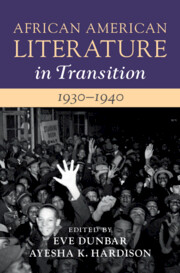Book contents
- African American Literature in Transition, 1930–1940
- African American Literature in Transition
- African American Literature in Transition, 1930–1940
- Copyright page
- Contents
- Figures
- Contributors
- Preface
- Chronology, 1930–1940
- Introduction
- Part I Productive Precarity and Literary Realism
- Chapter 1 Black Excesses and Deprivations in Literature and Photography of the 1930s
- Chapter 2 Arna Bontemps and Black Literary Archives
- Chapter 3 Black Women’s 1930s Protest Fiction
- Part II New Deal, New Methodologies
- Part III Cultivating (New) Black Readers
- Part IV International, Black, and Radical Visions
- Index
- References
Chapter 3 - Black Women’s 1930s Protest Fiction
from Part I - Productive Precarity and Literary Realism
Published online by Cambridge University Press: 25 March 2022
- African American Literature in Transition, 1930–1940
- African American Literature in Transition
- African American Literature in Transition, 1930–1940
- Copyright page
- Contents
- Figures
- Contributors
- Preface
- Chronology, 1930–1940
- Introduction
- Part I Productive Precarity and Literary Realism
- Chapter 1 Black Excesses and Deprivations in Literature and Photography of the 1930s
- Chapter 2 Arna Bontemps and Black Literary Archives
- Chapter 3 Black Women’s 1930s Protest Fiction
- Part II New Deal, New Methodologies
- Part III Cultivating (New) Black Readers
- Part IV International, Black, and Radical Visions
- Index
- References
Summary
The 1930s and the onset of the Great Depression mark a generic and geographic detour that illuminates Black women writers’ radical aims. Their short stories extend and revise aesthetics associated with New Negro women’s writing, like domesticity and racial passing. Black women’s protest short fiction also disrupts the masculinist character of proletarianism by demonstrating how gender and sexuality complicate notions of work, radical politics, and desire. These writers supplant urban crisis narratives with an emphasis on everyday struggles – to find work, to secure decent housing, to raise children, often alone, and to deal with racial as well as intimate partner violence. Their emphasis on intimacy attests to the roots of Black women’s protest traditions in nineteenth-century abolitionism. The intersectional approaches of 1930s writers anticipate not only the postwar fiction of writers like Ann Petry, Gwendolyn Brooks, Lorraine Hansberry, and Alice Childress but also Black feminist writing in the latter part of the twentieth century by Toni Cade Bambara, Toni Morrison, Louise Meriwether, Gloria Naylor, and Alice Walker, among others.
Keywords
- Type
- Chapter
- Information
- African American Literature in Transition, 1930–1940 , pp. 86 - 108Publisher: Cambridge University PressPrint publication year: 2022



